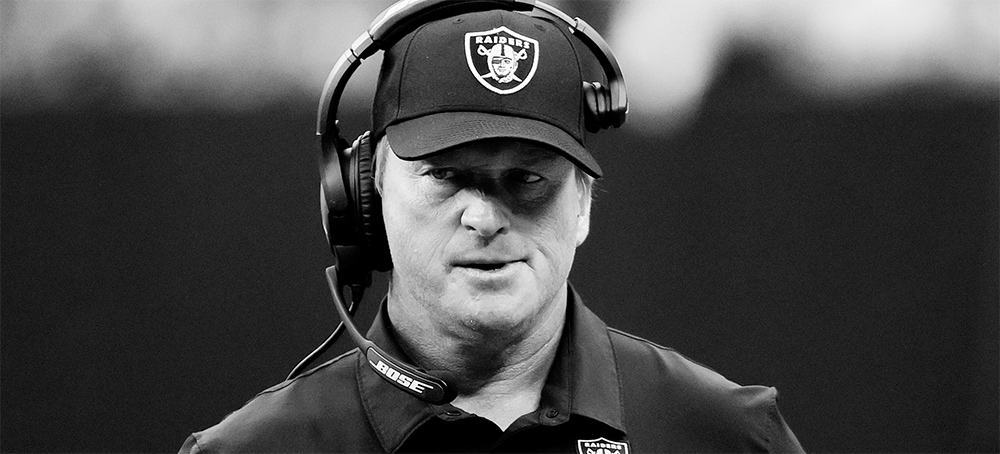Live on the homepage now!
Reader Supported News
The deposed Raiders coach expressed bigoted attitudes that are all too common in the NFL.
Gruden made racist, homophobic, and misogynistic comments in emails for nearly a decade, but he was forced out only when some of those reprehensible statements became public. Last week, The Wall Street Journal reported that in a 2011 email to the former Washington Football Team general manager Bruce Allen, Gruden referred to DeMaurice Smith, the executive director of the NFL Players Association, as “Dumboriss Smith” and said that Smith, who is Black, had lips the size of Michelin tires.
And then on Monday, The New York Times dropped more bombshells, reporting that, in other messages to Allen over the course of seven years, Gruden called NFL Commissioner Roger Goodell a homophobic slur; opposed the presence of gay players in the NFL; exchanged pictures of nearly naked women, including Washington cheerleaders; mocked the league for having women referees; and railed against players who protested during the national anthem. Gruden was an ESPN analyst during the period when he sent the messages, which ended in 2018—the year the Raiders hired him back as head coach. (He had previously coached the team from 1998 to 2001.)
After his true feelings about Smith surfaced, Gruden proclaimed, “I never had a blade of racism in me.” Turns out, Gruden had a football field’s worth of racism, sexism, and homophobia in him that had yet to be exposed.
Now fans are left to wonder how Gruden’s views influenced how he operated as a head coach, both with the Raiders and when he was with the Tampa Bay Buccaneers, from 2002 to 2009. Most NFL players are Black. Gruden has held positions that not only required him to interact intimately with players, but also gave him a big role in deciding their futures. He also coached the Raiders defensive lineman Carl Nassib, the first active NFL player to publicly come out as gay. People in marginalized groups commonly find themselves in this precarious and frightening scenario: Their fate is being determined by someone who disrespects and dehumanizes them.
The most disturbing aspect of this scandal is that, in the NFL, Gruden’s mentality isn’t an anomaly.
Gruden’s emails came to light as part of a larger investigation into the Washington Football Team’s culture. Last year, several women came forward in The Washington Post to detail how sexual harassment and other forms of misogyny were prevalent within the organization.
The NFL opened its own investigation to look into the allegations, and the results were far from transparent or satisfactory. The NFL fined Washington $10 million, but unlike in other league investigations, such as that into Deflategate, the league refused to publicly release any written materials related to its findings. Dan Snyder, the team’s owner, also handed over day-to-day operations of the team to his wife, Tanya, and agreed that they and other team executives would take part in workplace-conduct training.
Once Gruden’s emails to Allen surfaced, according to the Times, Goodell told league executives to examine more than 650,000 emails from the past few months, likely because even Goodell knows that Gruden’s narrow-minded views are held by many more coaches, owners, and team executives.
The NFL Players Association has urged the league to release the emails, but that request seems unlikely to be granted, because the NFL promised confidentiality when it began its investigation.
Besides, the image-conscious NFL has no interest in the public knowing the depth of prejudice that exists in the league, even though the NFL has proved quite clearly that it’s neither progressive nor inclusive. The NFL has had one Black team president in its 101-year existence. Currently, the league has three Black head coaches, and it has never had a majority owner who is Black.
The NFL has sent the message repeatedly that it is more comfortable with Black people as laborers, rather than leaders. Gruden could find an NFL team to hand him $100 million; the players Colin Kaepernick and Eric Reid, in contrast, both suffered professionally because they knelt during the national anthem in order to make people more aware of racial injustice and oppression. Urban Meyer, another coach in the hot seat in the past week, hired Chris Doyle as the Jacksonville Jaguars’ strength coach—even after numerous players for the University of Iowa, Doyle’s former employer, described a pattern of racially offensive comments. (Meyer changed his mind after an outcry.) Meanwhile, teams refuse to give head-coaching jobs to Byron Leftwich and Eric Bieniemy, Black offensive coordinators who have won Super Bowls for their respective teams, Tampa Bay and Kansas City.
Kaepernick and Reid sued the NFL, accusing teams of colluding to keep them from playing. One reason the NFL settled that case was that doing so would keep NFL owners’ depositions and other evidence from becoming public. If Gruden was so comfortable making vile comments in writing to an NFL team executive, imagine what NFL owners, coaches, and other officials were saying behind closed doors about Kaepernick, Reid, and other Black players who chose to be just as outspoken.
The NFL does a fantastic job of covering for its lack of progressiveness. In 2014, the league reportedly cut a deal with the Rams that in exchange for drafting Michael Sam—the first openly gay player drafted in pro football—the team would not have to appear on the NFL’s HBO show, Hard Knocks, which follows a different team every year in training camp. Many teams view the show as a distraction; for the league, a chance to avoid taking part in it was a carrot to dangle when officials didn’t want to explain why not one single team would take a chance on drafting an openly gay player. (The Rams’ then-coach, Jeff Fisher, strongly denies any deal with the NFL.)
Notwithstanding the occasional polite, performative gesture, the culture of football won’t improve as long as people like Gruden are elevated, protected, and prioritized in the NFL’s hierarchy. Now that his emails have become public, Gruden makes a convenient sacrificial lamb, but his departure doesn’t change the bigger picture.
No matter how many social-justice slogans the NFL stencils in its end zones or allows players to put on their helmets, no matter how many prominent Black artists the league hires to perform during its Super Bowl halftime show, no matter how much money the NFL gives to anti-prejudice organizations, it will never fix its own corrosive, institutionalized racism without more fundamental change. Unless the league chooses to confront prejudice in substantive ways, bigots will continue to protect bigots, and power will continue to protect power.
 Prescription pill bottles. (photo: Getty Images)
Prescription pill bottles. (photo: Getty Images)
Former Democratic lawmakers now earn a living as drug company lobbyists.
“We tried desperately to allow the secretary of [the Department of Health and Human Services] to negotiate, using all 42 million seniors as a negotiating tool, to bring down the cost of pharmaceuticals,” said Lincoln, staring down her Republican opponent during a televised debate. “And we weren’t allowed to do that. At least two times I voted on that amendment.”
Days later, she won her reelection campaign. But six years after that race, Lincoln was swept out of office during the 2010 congressional midterm elections, due in part to an infusion of drug company dark money that flowed into the race.
Lincoln now serves Pfizer as a lobbyist focused on blocking the very cost-saving proposal she once championed. The Lincoln Policy Group, a firm she founded, brings in about $20,000 per month working to maintain the ban on Medicare negotiating lower drug prices that is now being weighed in Congress’s budget reconciliation package.
In strategy calls with other drug company officials, Lincoln has worked to fight the drug pricing proposal. And in recent weeks, the former senator has continued to socialize with Democratic leadership, including making an appearance at a recent rooftop party in Washington, D.C., where House Majority Whip Rep. James Clyburn, D-S.C., and Sen. Chris Coons, D-Del., were in attendance.
The popular, once bipartisan idea to hold down Medicare costs is now at the center of President Joe Biden’s domestic agenda. Legislation backed by the administration calls for Medicare to mirror other government agencies, such as the Department of Veterans Affairs, in being able to negotiate for cheaper medicine through the Part D program.
The idea could potentially save the government nearly $500 billion over a decade, freeing up funds to pay for the expansion of other Medicare programs, including a new proposed benefit to cover dental, vision, and hearing care that is part of the president’s so-called Build Back Better plan. The drug pricing proposal could also translate to lower prescription costs across the board, as private health insurers would also have access to the reduced prices.
The drug industry, according to its top lobbyist, Stephen Ubl, has made defeating the provision its top priority, calling the legislative effort “an existential threat to the sector.” The industry has marshaled major resources, including calls from patient advocacy groups and sponsored advertising in key districts.
But inside the Beltway, the opposition is coming from familiar faces. Many leading Democratic lawmakers and staff have been hired by the drug industry to convince their former colleagues to abandon the drug pricing proposal.
The Democratic National Committee held its very first indoor, in-person fundraiser this year on the rooftop of Brownstein Hyatt Farber Schreck, a prominent law firm that helps drug companies such as Eli Lilly and Co., Johnson & Johnson, and Roche influence the drug pricing debate. Lobbyists from the firm mingled with DNC Chair Jaime Harrison and other prominent Democratic officials, according to a report about the event.
Lincoln’s onetime colleague, former Sen. Mark Pryor, D-Ark., also works at Brownstein as a lobbyist for Eli Lilly and Co. Pryor, like Lincoln, voted to allow Medicare to negotiate for lower drug prices when he served in office, before making the jump to the private sector. In 2007, Pryor appeared with other Senate Democrats and activists to demand action on lowering prescription drug prices by lifting the prohibition on Medicare’s negotiating power.
Pfizer alone has assembled a lobbying team that includes Dean Aguillen, a former adviser to House Speaker Nancy Pelosi, D-Calif.; Remy Brim, a former health policy adviser to Sen. Elizabeth Warren, D-Mass.; and over half a dozen aides to senior Senate Democrats.
Ann Jablon, former chief of staff to Rep. Richard Neal, D-Mass., the current chair of the Ways and Means Committee, with jurisdiction over tax-writing policy, currently represents several drug companies as a lobbyist, including Amgen Inc., Astellas Pharma, and Bayer.
Pharmaceutical Research and Manufacturers of America, the trade group that represents the largest drug companies in the world, has also gone on a hiring spree of Democratic lobbyists, adding Vin Roberti, a prominent fundraiser close to Pelosi, to its roster of 185 registered lobbyists earlier this year. In recent months, PhRMA has hired other firms with close ties to congressional Democrats, including Thorn Run Partners, Foley & Lardner LLP, and Tiger Hill Partners. In July, PhRMA hired Christopher Putala and his firm, Putala Strategies, as a contract lobbying firm. Putala is a former aide to Biden.
The drug industry has even retained some influence among its most outspoken critics. Michaeleen Crowell, former chief of staff to Sen. Bernie Sanders, I-Vt., is working as a lobbyist on behalf of drug company Horizon Therapeutics PLC against the Medicare pricing proposal.
Of course, it’s not only Democratic staff and lawmakers retained by drugmakers. Former Sen. Jon Kyl, R-Ariz., is retained by both Merck and PhRMA, while former Rep. Tom Davis, R-Va., works for Pfizer. Dozens of former GOP aides make a living as drug industry lobbyists.
The tidal wave of influence spending appears to be paying off. Not only are GOP lawmakers standing firm against any measure to allow Medicare to use its bulk buying power to bring down prices, but a few conservative Democrats have also broken ranks to threaten the proposal.
Last month, a group of centrist House Democrats, including Reps. Kurt Schrader, D-Ore.; Scott Peters, D-Calif.; and Kathleen Rice, D-N.Y., joined with Republicans to vote against adding the Medicare drug pricing language to the $3.5 trillion social spending bill in the House Energy and Commerce Committee. Instead, they support a counterproposal that would limit the drugs Medicare could negotiate. Schrader and Peters have both received significant campaign cash from the pharmaceutical industry.
 Millions of retirees on Social Security will get a 5.9% boost in benefits for 2022. (photo: Jenny Kane/AP)
Millions of retirees on Social Security will get a 5.9% boost in benefits for 2022. (photo: Jenny Kane/AP)
The Social Security Administration announced Wednesday that Social Security and Supplemental Security Income, or SSI, benefits will get a 5.9% cost-of-living adjustment, or COLA, in 2022 — the largest increase since 1982. The announcement comes amid soaring inflation as the economy struggles to recover from the pandemic.
Here’s what to know about the increase.
Who will get the increase?
Roughly 70 million Americans will see their Social Security or SSI benefits increase by 5.9%, according to the SSA.
The boost will translate to an average monthly increase of $93 for retired workers, $47 for the spouse of a retired worker, $87 for an “aged” widow or widower, $46 for a widow or widower who is disabled, and $75 for a worker who is disabled, according to estimates from the SSA.
The “monthly maximum federal” SSI amounts in 2022 will be “$841 for an eligible individual, $1,261 for an eligible individual with an eligible spouse, and $421 for an essential person,” the SSA said.
“Social Security and SSI beneficiaries are normally notified by mail starting in early December about their new benefit amount,” the SSA said Wednesday. “Most people who receive Social Security payments will be able to view their COLA notice online through their personal my Social Security account. People may create or access their my Social Security account online at www.socialsecurity.gov/myaccount.”
When will the increase start?
The boosted payments will begin on Dec. 30 for roughly 8 million SSI beneficiaries, and the adjustment to benefits payable to more than 64 million Social Security recipients will start in January 2022, the SSA said.
How was the increase decided?
People who receive retirement or disability benefits get a cost-of-living boost each year to keep up with inflation.
Since 1975, the SSA has increased Social Security’s “general benefit” based on increases in cost of living as measured by the Consumer Price Index, which is “a measure of the average change over time in the prices paid by urban consumers for a market basket of consumer goods and services.”
The SSA “starts with” the Consumer Price Index for Urban Wage Earners and Clerical workers, or CPI-W, which measures the monthly change in the price of a basket of goods and services like food, health care and energy, according to the AARP.
“SSA then calculates the COLA by comparing the average of the CPI-W for July, August and September of the previous year with the average for the same three-month period in the current year,” the AARP said. “The percentage change is the COLA for the following year.”
Why the increase matters
The increase comes during a surge in inflation. The Consumer Price Index for All Urban Consumers, or CPI-U, increased 0.4% in September after increasing 0.3% in August, according to the Bureau of Labor Statistics.
Over the last year, inflation rose 5.4% before the seasonal adjustment.
Charles Blahous, a retirement policy expert and former public trustee who helped oversee Social Security and Medicare finances, told the AP that “regardless of the size of the COLA, you never want to minimize the importance of the COLA.”
“What people are able to purchase is very profoundly affected by the number that comes out,” Blahous said. “We are talking the necessities of living in many cases.”
Some experts had predicted the 2022 COLA could be the highest in decades, including the Senior Citizens League, which in August predicted a 6.2% increase. David Certner, legislative counsel and director of legislative policy for government affairs at AARP, said in a blog post that the COLA will “no doubt be higher than it has been for the last decade” because of rising prices.
Previous COLAs
The 2022 COLA is the highest since 1982, when it was 7.4%.
Since then it has only surpassed 5% twice — in 1991 when it was 5.4% and in 2009 when it was 5.8%.
For most of the past decade, the COLA has remained around or below 2%, including in 2021 when it was 1.3% and 2020 when it was 1.6%, according to the SSA.
 More than 10,000 John Deere workers in Iowa, Illinois, Kansas, Colorado and Georgia went on strike early Thursday after contract negotiations deadlocked. (photo: Nati Harnik/AP)
More than 10,000 John Deere workers in Iowa, Illinois, Kansas, Colorado and Georgia went on strike early Thursday after contract negotiations deadlocked. (photo: Nati Harnik/AP)
The walkout is the latest by an emboldened labor movement and affects 14 plants in Iowa, Illinois, Kansas, Colorado and Georgia.
The company’s offer included raises of 5 to 6 percent, but union officials said the proposed contract didn’t meet workers’ retirement and wage goals. With companies nationwide struggling to fill jobs and grappling with supply chain tie-ups, union officials say they are seizing the moment to regain benefits they lost in the late 1990s, when an era of assembly-line layoffs and outsourcing diminished unions’ leverage.
“The cards are in our favor right now … it’s never been lined up this well for us,” said Chris Laurson, a longtime worker at the John Deere plant in Ottumwa, Iowa.
Laurson pointed to the company’s record profits, as well as the huge pay raise awarded chief executive John May. “The labor shortage is in our favor too,” he said. “Deere can’t hire enough people with the package they’re offering right now.”
A John Deere spokesman said the company is committed to reaching a favorable outcome, one that would “put every employee in a better economic position and continue to make them the highest-paid employees in the agriculture and construction industries.”
The strike includes more than 10,000 workers at 14 Deere plants, including seven in Iowa, four in Illinois and one each in Kansas, Colorado and Georgia. The company has activated a continuity plan that will bring in nonunion employees to keep operations running. “Our immediate concern is meeting the needs of our customers, who work in time-sensitive and critical industries such as agriculture and construction,” the John Deere spokesman said.
The strikes are hitting a wide range of industries, encompassing skilled assembly-line workers, nurses, pharmacists and Hollywood stagehands. Thousands have gone on strike at food plants operated by Kellogg’s, Nabisco and Frito-Lay over work hours, pay and benefits. On Monday more than 24,000 Kaiser Permanente workers authorized a strike over a new two-tiered pay and benefits system opposed by the union. And Hollywood production workers announced plans to strike Monday in pursuit of improved pay and working conditions.
All of them are asking for a larger share of pandemic-era profits, as many of these companies have seen their fortunes surge over the past year. John Deere, for example, saw its earnings reach a record $1.79 billion during the second quarter of 2021, nearly doubling last year’s profits.
John Deere contends that its assembly-line workers already have some of the best wages and benefits in their respective industries. A typical employee makes about $60,000 per year, according to wage figures published by the company. The now-rejected contract offer would have increased it to nearly $72,000.
Laurson, the Iowa union official, said the strike is really about winning back benefits that workers lost long ago. The company currently operates under a two-tiered system with smaller pensions than workers enjoyed in the ’90s, he said.
“Fast-forward 19 years, after many concessionary contracts, here we are with a membership that’s better-informed,” Laurson said in an interview Thursday.
Toby Munley, an electrician at the Ottumwa plant, is in his 18th year with the company and worries whether he will be taken care in retirement.
He and his colleagues have been comparing their benefits to those of previous generations and believe they are coming up short. He notes that his father-in-law received health-care benefits in retirement that he won’t, as did his grandmother, who was married to a John Deere worker.
“We need a light at the end of the tunnel,” he said.
The autoworkers union is receiving some help from the Teamsters union of truck drivers, who Laurson said are helping hold the company’s picket line. Some other trucks working for a nonunionized contractor are crossing the picket line to deal with some concrete work, he said.
“A semi just tried to turn into the entrance to load up some bailers, and everybody shouted ‘NOOOOO!’,” Laurson said, taking a reporter’s call from the Iowa picket line. “He looked at us like ‘what do I do?’ and then kept going.”
 A unhoused person sleeps at MacArthur Park in Los Angeles in 2020. (photo: Apu Gomes/AFP/Getty Images)
A unhoused person sleeps at MacArthur Park in Los Angeles in 2020. (photo: Apu Gomes/AFP/Getty Images)
Unhoused residents fear they’ll end up back on the street after MacArthur Park closure: ‘This won’t solve the problem’
MacArthur Park, in the city’s Westlake neighborhood, is one of many public spaces in LA that became a popular camping spot for unhoused Angelenos during the pandemic, drawing hundreds of campers.
At the end of September, city leaders announced that the park would be closing for “maintenance” work, with officials giving unhoused residents until Friday at 10.30pm to vacate.
The closure, which officials say is temporary, follows the controversial clearing of an encampment in nearby Echo Park and comes as the city is struggling to grapple with a humanitarian crisis that has significantly worsened since the pandemic.
Advocates and unhoused people at the park said this week that there is confusion and anxiety about what lies ahead. “I don’t know how this is going to work out,” said Fatima Rodriguez, 28, as she cleaned the area outside her tent on Monday, four days before the closure.
The LA native said she had been living on the streets for about a year, sometimes in the park and sometimes under a bridge, and that she wasn’t sure what shelter options were available: “I just want to know how long the park will be closed.”
‘We had no options’
More than 66,000 people were homeless in LA county at the start of 2020. Once Covid hit, shelters and other programs reduced services, and large encampments grew. Pandemic rules restricted the city from evicting people from makeshift tent sites.
Some residents chose to move to park encampments with established communities of tents, saying they provided a better option than group shelters – which could expose them to Covid – or hidden alleys and underpasses, where they could be more vulnerable to violence.
Echo Park and MacArthur Park both drew large crowds of unhoused people.“It’s not that we want to be in the park, it’s just that we have no choice,” said Gustavo Otzoy, 55, wholived at MacArthur Park earlier this year after the city shut down the Echo Park encampment where he had been staying.
Located in a neighborhood home to many Central American immigrants, MacArthur Park is known for its lake and picturesque fountain, a popular soccer field, a pavilion for outdoor performances and a large population of geese.
The area has plenty of open space where people could set up tents and advocates say there are benefits when groups gather near each other. “Having people in one place has kept them in touch with services, has kept them fed, has got them water,” said Robin Lifland, an advocate who lives next to the park and has helped organize donations for the unhoused residents. Over the last year, the park has seen mobile shower programs, regular food drop-offs, outdoor church events, Covid testing and vaccine clinics.
But life at the park has also been extremely difficult, with unhoused residents raising concerns about physical and sexual assaults, frequent fights, fires and other safety hazards. Many encampment residents have struggled with severe mental health challenges, addiction, overdoses and health problems – oftentimes, conditions that were created or exacerbated by living outdoors.
Officials said gang-related violence in the area made the park particularly dangerous for homeless residents, though some advocates have argued the city was fear- mongering about crime and that high-profile cases of violence were not related to the unhoused community.
‘People scatter and disappear’
In January, the Los Angeles Homeless Services Authority (Lahsa) and People Assisting the Homeless (Path), a not-for-profit group working with the city to service the homeless, began sending outreach workers to the park.
“Our unhoused neighbors were really being preyed upon. So we’ve definitely seen an eagerness to go inside,” said Jennifer Hark-Dietz, Path’s deputy CEO.
In the past year, the city and its homeless service partners have increasingly focused on specific locations that developed large encampments during Covid. The goal, said Colleen Murphy, Lahsa’s manager for unsheltered strategies, was to build trust in a specific tent community through persistent outreach in one area, and to get them connected to appropriate shelter options, services and treatment. Outreach workers have primarily relied on Project Roomkey, a pandemic program, to offer residents temporary motel stays.
Meanwhile, the city has escalated its crackdown on tent communities and people sleeping outside. The city faced widespread backlash in March when it evicted the encampments at Echo Park Lake, aided by a militarized police force that arrested nearly 200 people who protested the park’s closure.
Over the summer, authorities cleared massive encampments from the Venice Beach boardwalk, and the city council also passed a new law further restricting sleeping on certain public property. City leaders have promised to offer shelter to unhoused people when requiring them to move. But in practice, the housing initiatives have had mixed success, with reports of many ending up back on the street.
In March, the police department spent $2m over four days enforcing the closure of Echo Park. A Lahsa spokesman said this week that of the 183 people who were living in the park before its shutdown, only four people have been placed in permanent housing. The majority of the remaining residents are still in temporary housing, Lahsa said.
But Ananya Roy, director of UCLA’s Institute on Inequality and Democracy, who is studying the Echo Park displacement, said her group was in contact with residents who returned to the streets after their initial placements, and that it was unclear if residents in shelters would receive permanent housing. “People are scattered and disappeared,” she said. “And there’s just a waning of what I call Covid compassion. We’re on the brink of a regime of pretty severe exclusion.”
The Venice efforts have been more successful: out of 213 people who were moved off the boardwalk, 46 are now in permanent housing, and 167 are in interim shelter, according to St Joseph Center, a local service provider.
Murphy noted that the vast majority of people who get permanent housing stay housed, but that the region couldn’t keep up with the demand: “We’ve helped a lot of people get indoors, but we don’t have the supply of permanent housing.” More than 200 people fall into homelessness every day in the region, according to government statistics – and the problem could soon get much worse with the state ending its Covid eviction restrictions.
The homelessness crisis has become a top issue in recent political races. Some Venice residents sued the city to try to force the closure of encampments, and groups across LA have pressured their local representatives to be tougher on residents living outdoors, arguing that tent sites can be dangerous and hazardous.
High-profile politicians have campaigned alongside encampment critics, promising to “clean up the streets” and “arrest” people who refuse to move.
The LA county sheriff, who is facing reelection, has warned that unhoused people were flocking to LA to “destroy our community”, and has criticized government assistance programs that aid “nomadic” people, even though the majority of the LA homeless population was living in LA when they became unhoused.
Preparing for the shutdown
At MacArthur Park, 257 people have moved into some kind of shelter since January, according to the office of Gil Cedillo, a council member whose district includes the park. Although the population has dramatically declined, tents remained scattered throughout the area in the final days before the shutdown.
Cedillo said that the park closure was necessary for electrical repairs, landscaping, irrigation upgrades, and sign and furniture replacement, and that part of the park would remain open.
At the park this week, police cars roamed throughout the pedestrian paths, at times questioning unhoused residents who remained. At least one individual was detained on Monday, though it’s unclear why.
“Their purpose is to harass and bully,” said Lesly Lynch, 70, an unhoused resident who was spending time at the park but no longer camps there. “This is not going to solve the problem,” he said of the closure, noting that some people won’t stay in shelters because of the strict rules and challenging environment.
Otzoy, who had stayed at Echo Park and MacArthur, works as a handyman and said the motel program felt “like a jail”. The curfews interfered with his work schedule, and he wasn’t allowed to keep his tools, he said, adding that the MacArthur Park renovations shouldn’t require a fenced-off closure: “That’s just an excuse.”
“They need to concentrate on more important things – like housing,” added Jimmy Glenwood Sr, 72, another unhoused resident sitting on a bench nearby.
“It’s security theater at best for people who are housed and complaining,” argued Sherin Varghese, the co-founder of Ktown for All, a volunteer advocacy group for unhoused people. “It’s an illogical approach that prioritizes aesthetics over humanity.”
Stacy White, an unhoused resident who was camping at MacArthur but has now moved into a shelter, recently returned to help friends who remained. She said she supported the park closure, given how dangerous it had become for unhoused people. “I don’t want to die outside,” she said. But she was not confident that people would get the help they need: “Nothing is gonna change.”
José Felix Cabrera Larios, vice-president of the MacArthur Park Neighborhood Council, said he was glad the park would be improved and was hopeful there would be no encampments in the future: “Before the pandemic, rules were followed. And the rules will be followed once the park reopens.”
Cedillo, the council member, declined an interview request. A spokesman said he could not say whether people who refused to leave would face arrest on Friday: “The park is closing, and we’re asking everyone to leave.”
 Former Sri Lankan navy chief Admiral Wasantha Karannagoda. (photo: AP)
Former Sri Lankan navy chief Admiral Wasantha Karannagoda. (photo: AP)
Probe against Admiral Wasantha Karannagoda was part of a case that cast a spotlight on extrajudicial killings during the nation’s 37-year ethnic war.
The investigation against Admiral Wasantha Karannagoda was part of a case that cast a spotlight on extrajudicial killings during Sri Lanka’s 37-year ethnic war that ended in 2009.
Attorney General Sanjay Rajaratnam on Wednesday told the Court of Appeal that the state will not pursue charges against Karannagoda, who was first indicted in 2019.
A court official told AFP news agency that a lower court would soon discharge Karannagoda, who is one of 14 people accused of abducting the teenaged children of wealthy families in 2008 and 2009 and killing them after extorting money.
Four charges had been laid against him, including conspiracy to murder, which carries the death penalty.
Rights watchdog Amnesty International urged Sri Lankan authorities to explain why they dropped the case.
The killing of the 11 youths was raised at the UN Human Rights Council, which called for independent investigations into atrocities during the separatist war.
Police told a court in 2019 that the 11 victims were killed while in the illegal custody of the navy, although their bodies have never been found.
Investigators believe the true number of victims from the abductions and killings to be at least three times higher.
Police said the victims were not linked to ethnic Tamil separatist rebels and were kidnapped purely to extort money from families. Some were killed even after cash was handed over.
Military figures have been widely accused of extrajudicial killings during the war.
The final days of the offensive against the Tamils were marked by serious abuses, according to rights groups.
A UN panel has said 40,000 civilians may have been killed in the final stages of the conflict.
 Chevron. (photo: Joe Raedle/Getty Images)
Chevron. (photo: Joe Raedle/Getty Images)
The oil giant's aspiration to reduce emissions just means "cleaner" fossil fuels.
But even after the majority shareholder vote, Chevron is barely budging.
On Monday, Chevron announced a new “aspiration” to reduce emissions from its upstream operations to net-zero by 2050, along with a separate target of reducing the carbon intensity of its products by 5 percent by 2028. That mouthful of words means the company plans to keep producing just as much oil as it always has, if not more, but emit less carbon per barrel.
Activist shareholders were not impressed with the update.
“Expectations are that this company begins transitioning meaningfully, and we are simply not seeing that,” said Danielle Fugere, president of the investor advocacy nonprofit As You Sow. “The 5 percent reduction announced today is insufficient to demonstrate that the company is hearing investors.”
Shareholders voted for Chevron to reduce its so-called “scope 3 emissions,” the carbon released when customers burn its oil and gas in their cars and homes, which makes up about 90 percent of the company’s carbon footprint. The only way for Chevron to meaningfully reduce its scope 3 emissions would be to shift its business to produce different products that don’t emit carbon. Instead, the company is mostly doubling down on oil and gas, but committing to making its production processes cleaner, starting with its “upstream operations” — the industry term for activities associated with exploration and extraction.
Chevron’s upstream operations include drilling for oil and natural gas, pumping it out, transporting it via pipeline, and in some cases, converting natural gas into a liquid. Most of the company’s upstream greenhouse gas emissions come from powering heavy machinery or from “flaring,” the practice of burning off excess gases that rise up out of wells. Ironically, Chevron plans to reduce upstream emissions in part by electrifying equipment and powering it with solar and wind farms. Instead of supporting an economy-wide transition to renewable electricity, which would lower emissions in an absolute sense, the plan aims to exploit renewables to produce more fossil fuels, potentially holding total emissions at a steady level.
Chevron also plans to incorporate more carbon capture and storage technology into its operations, but the company has a poor track record on that front. Chevron’s Gorgon gas processing plant in Western Australia, which was supposed to be the largest carbon capture and storage project in the world, has so far failed to capture as much carbon as promised.
And to eliminate the last 50 percent or so of its upstream emissions by 2050, the company has no plan. In a report that accompanied the net-zero announcement, a vague roadmap says that “innovation and offsets” will eventually help the company go from emitting the equivalent of 15 kilograms of CO2 for every barrel of oil it produces down to zero. Offsets are payments made to reduce or remove carbon emissions somewhere else when you can’t do it directly — this is where the “net” in net-zero comes from — but the potential quantity of offsets is limited and their effectiveness is debated.
And at the end of the day, none of these plans will make any difference for the climate if Chevron is still producing just as much oil and gas in 2050. Andrew Logan, director of oil and gas programs at Ceres, an investor advocacy group, said in a statement that the commitment was behind the times. “Net zero operational emissions targets are simply table stakes at this point — and a number of Chevron’s U.S. peers like ConocoPhillips made such a commitment some time ago,” he said.
Chevron’s other “aspiration,” to reduce the carbon intensity of its energy products by 5 percent by 2028, came with no detailed plan. The report released on Monday explains that’s just where the company expects to be after implementing existing plans like reducing emissions from its drilling operations and refineries and growing its investments in its New Energies business unit, which aims to develop technologies like carbon capture and hydrogen.
If you’ve listened to a podcast or watched TV recently, you might get the impression that Chevron’s New Energies division is becoming the core of its business. The company has been bombarding viewers and listeners with ads about its investments in carbon capture, biofuels, and hydrogen in recent months. These are changes that actually could reduce Chevron’s scope 3 emissions if it were truly prioritizing them. But the company’s investments in them are nominal compared to its spending on oil and gas. Chevron plans to allocate only about 10 percent of its capital spending to its New Energies business over the next several years.
“These same companies have been looking into these technologies for decades, and they’ve been investing small amounts of capital in them,” said Fugere. “The amount of capital being invested in solutions is far less than the capital being invested in business as usual.”
In Chevron’s report, the company makes explicit that it doesn’t plan to invest much more in its New Energies branch unless major international changes occur, like the steep economy-wide carbon price envisioned in the International Energy Agency’s net-zero scenario. Chevron calls that scenario, which presents a transition to a world powered mostly by renewable energy, “highly unlikely.”
Follow us on facebook and twitter!
PO Box 2043 / Citrus Heights, CA 95611



No comments:
Post a Comment